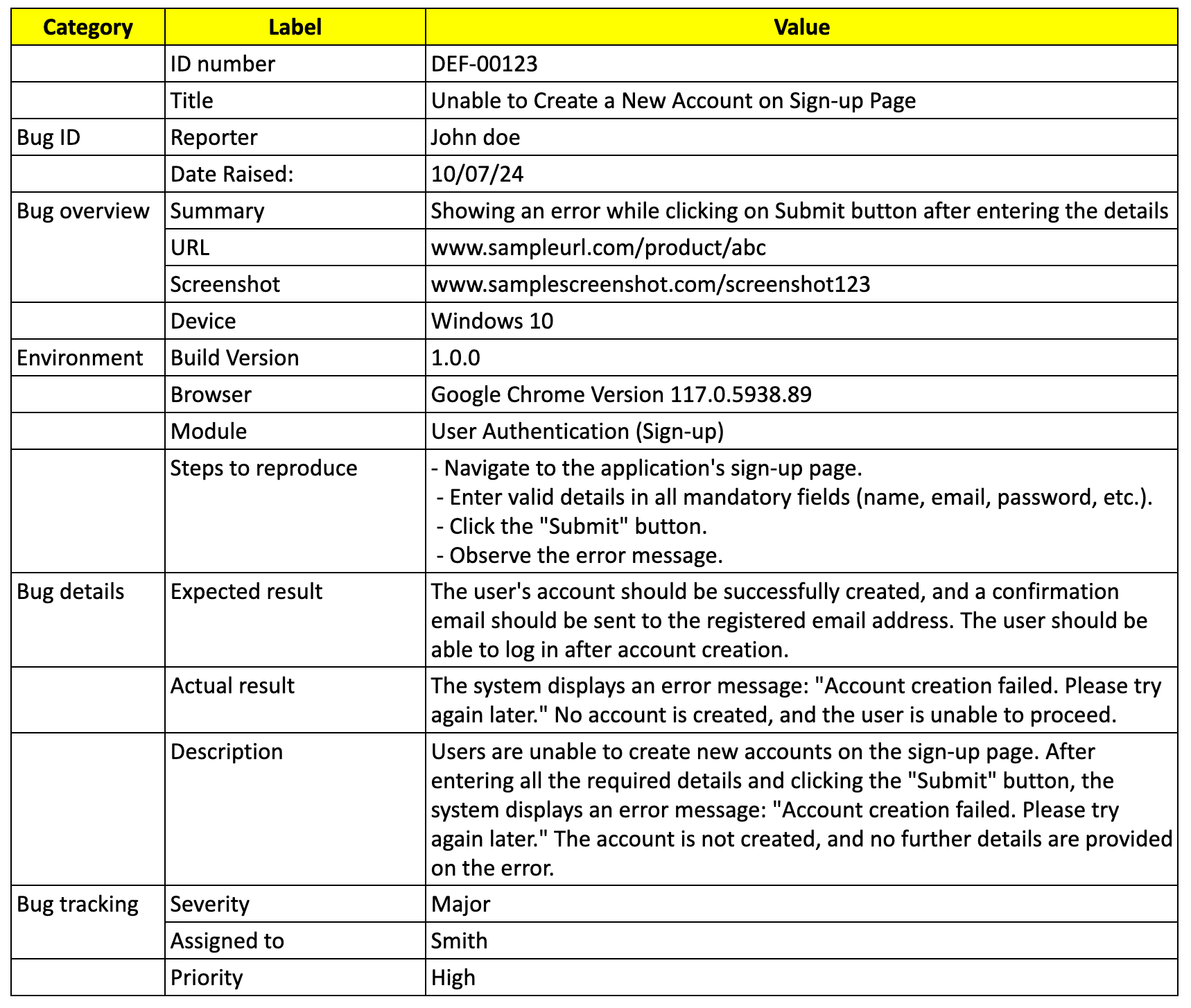How to Write a Good Defect Report in Software Testing

A defect report, also known as a bug report, is one of the critical deliverables in software testing. The end is achieved through such a report by conveying the problems or defects encountered during the testing process by the testing organization to the developers and other interested parties for solving the defects in good time before product delivery of the software. Therefore, the need for the creation of a precise, comprehensive, and correct defect report is necessary to ensure that bugs are tackled efficiently.
In this blog, we run through the critical elements of a good defect report and some tips on how to make it more effective.
What Is a Defect Report?
A defect report is a document that outlines a problem or inconsistency in the software that deviates from expected behavior. The goal of a defect report is to explain the problem in enough detail that developers can understand, reproduce, and fix the issue.
Good defect reports save time by clearly communicating the problem. Poorly written reports, on the other hand, can lead to confusion, delays, and rework.
Why Is a Good Defect Report Important?
A well-written defect report ensures:
- Developers can quickly understand and reproduce the issue.
- Bugs are resolved faster.
- There’s less back-and-forth between testers and developers.
- The overall software quality improves as issues are resolved effectively.
Key Elements of a Good Defect Report
To write a good defect report, include the following key elements:
1. Title
The title should give a brief summary of the defect. It should be concise but descriptive enough for developers to understand the issue at a glance.
Example: “Login button unresponsive on mobile after entering invalid credentials.”
2. ID
Every defect needs a unique identifier (ID). This allows teams to track the defect easily throughout the bug life cycle.
Example: Bug ID: #1234
3. Environment
Specify the environment where the defect was found. This includes details like the platform (Windows, macOS, Android), browser (Chrome, Firefox), and version of the software.
Example: “Tested on Android 11, Chrome version 94.0, App version 2.3.1.”
4. Severity and Priority
- Severity refers to how critical the defect is in terms of software functionality. Common categories include Critical, Major, Minor, and Trivial. Understanding the difference between severity vs priority is essential for effective defect management.
- Priority determines how soon the defect needs to be fixed. Priorities include High, Medium, and Low.
Example: Severity: Major, Priority: High
5. Description
Provide a detailed explanation of the defect. This should include what is happening, what should happen, and why it's considered a defect.
Example: “When a user enters incorrect login credentials and clicks the 'Login' button on the mobile app, the button becomes unresponsive, and no error message is shown. The expected behavior is for the system to display an error message without freezing the login button.”
6. Steps to Reproduce
This is one of the most important parts of a defect report. Write clear, step-by-step instructions so developers can replicate the issue.
Example:
- Open the mobile app.
- Navigate to the login screen.
- Enter an incorrect username and password.
- Click on the ‘Login’ button.
- Observe the unresponsive button.
7. Expected Result
Clearly state what should have happened if the defect didn’t exist.
Example: “The system should display an error message such as ‘Invalid username or password’ and allow the user to try logging in again.”
8. Actual Result
Describe what actually happens when the bug occurs.
Example: “The 'Login' button becomes unresponsive after clicking it, and no error message is displayed.”
9. Attachments
Include screenshots, logs, or video recordings to support your defect report. Visual proof often makes it easier for developers to understand the issue.
Example: Attach a screenshot showing the unresponsive button or a video capturing the steps to reproduce the bug.
10. Additional Information
If relevant, provide any extra details that may help developers diagnose or understand the defect. This might include:
- Error messages: Copy any error messages that appear during the defect.
- Network logs: Include logs if the issue might be related to server or network communication.
- Frequency: Mention how often the bug occurs (e.g., “It happens every time” or “Occurs sporadically”).
Example: “Occurs every time on Android, but not reproducible on iOS.”
Example of a Good Defect Report
Title: "Search Function Not Returning Results on Product Page in Firefox"
- Bug ID: #3456
- Environment: Firefox version 93.0, Windows 10
- Severity: Major
- Priority: Medium
- Description: When using the search function on the product page in Firefox, the results do not display, even though the same search works correctly in Chrome.
- Steps to Reproduce:
- Open Firefox on Windows 10.
- Navigate to the product page of the e-commerce website.
- Enter a product name in the search bar.
- Click the search button.
- Expected Result: A list of products matching the search query should be displayed.
- Actual Result: No results are shown, and the page remains blank.
- Attachments: Screenshot of the blank page after clicking search.
- Additional Information: Works as expected in Chrome and Safari. No error messages appear in Firefox Developer Console.
Sample Defect Report in Software Testing

Best Practices for Writing Defect Reports
- Be Clear and Specific: Avoid vague language. Make sure the report is specific and detailed enough for developers to understand without needing to ask for more information.
- Stay Objective: Stick to facts and avoid assumptions. Report only what you observe, not what you think the problem might be.
- Use Simple Language: Write the defect report in simple, straightforward language that can be understood by anyone, regardless of their technical background.
- Be Consistent: Use a consistent format for all defect reports. This makes it easier for the team to understand and process multiple reports.
- Proofread Before Submitting: Double-check your defect report for accuracy and completeness before submitting. A typo in a step or missing information could lead to delays in resolving the issue.
Conclusion
A good defect report helps in effective communication among the testers and developers. Once written clearly, a defect report ensures that a bug is understood, reproduced, and finally fixed in less time than would have been required with an ambiguous report to meet the quality of the software. You are making a big contribution to the efficiency of the testing and development process by including clear titles, step-by-step details for reproducing, expected and actual results, and attachments relevant to the findings. Keep practicing these skills, and soon writing defect reports will become second nature!
Effective defect reporting goes hand in hand with other testing practices. Familiarizing yourself with types of automation testing and writing effective test cases can significantly improve your defect reporting skills.
Need Expert Help?
If you're struggling with defect reporting or need assistance in improving your software testing processes, F22 Labs can help. Our comprehensive Software Quality Assurance Services ensure your software meets the highest standards of quality and reliability. Contact us now!
